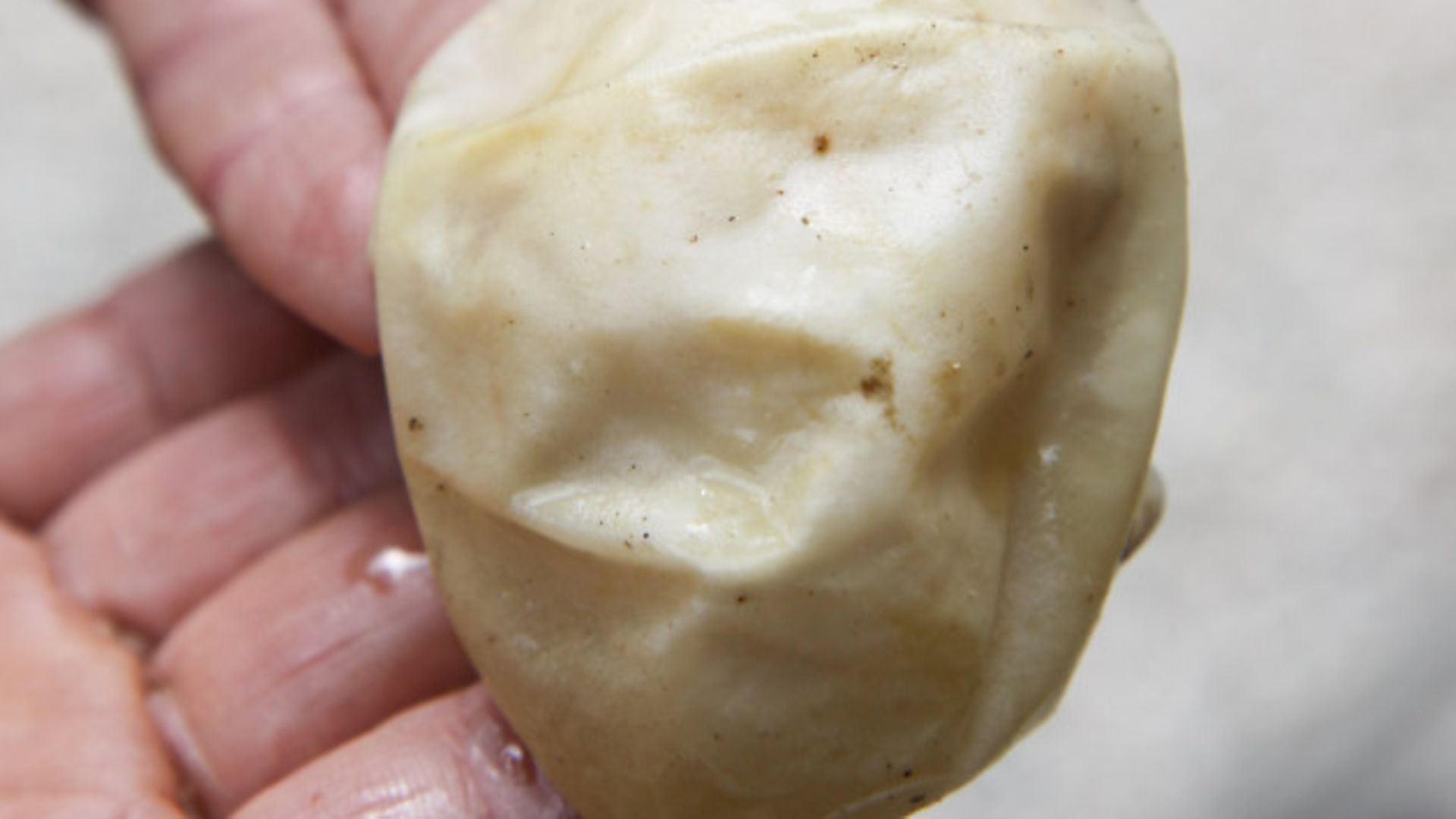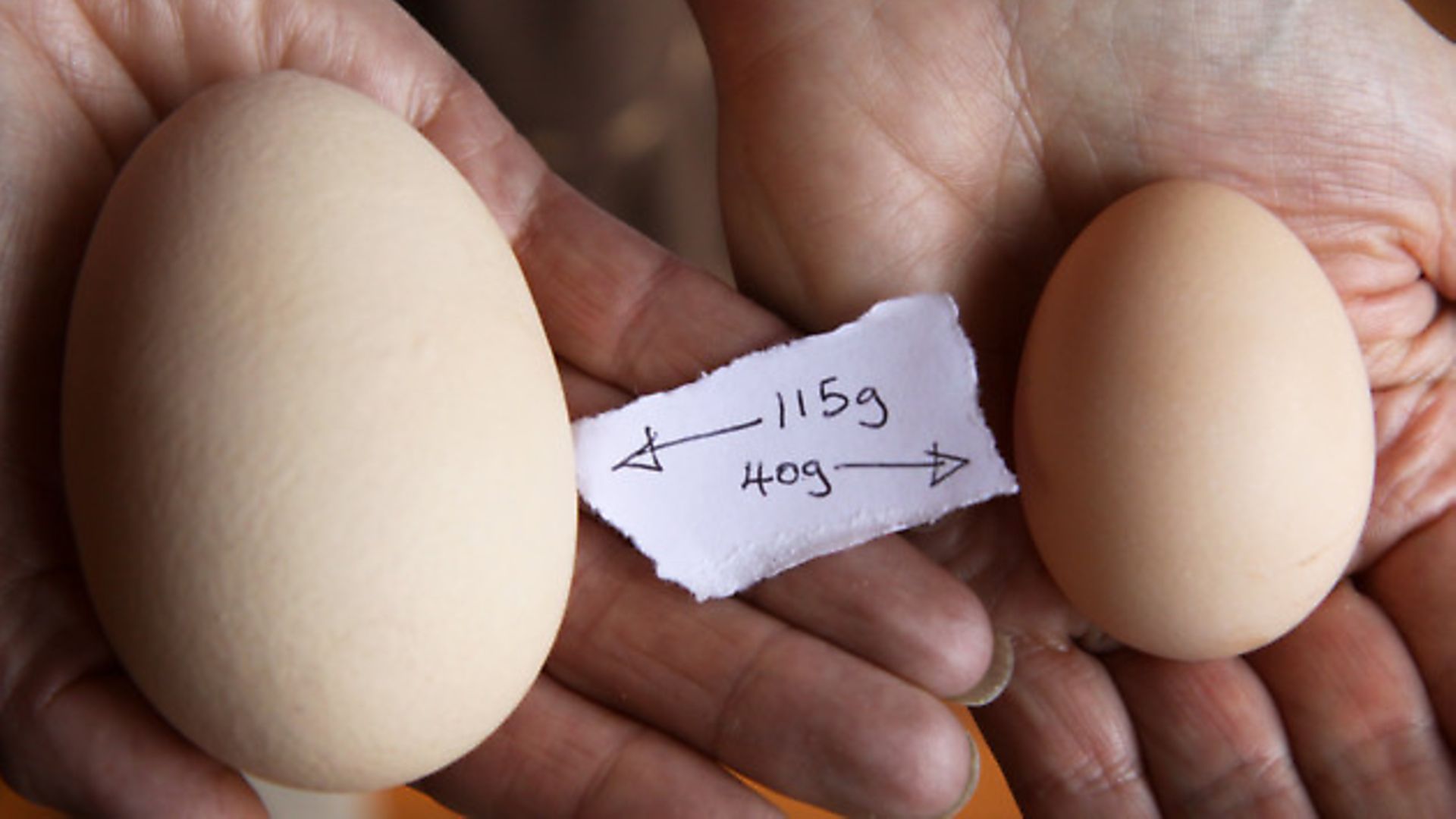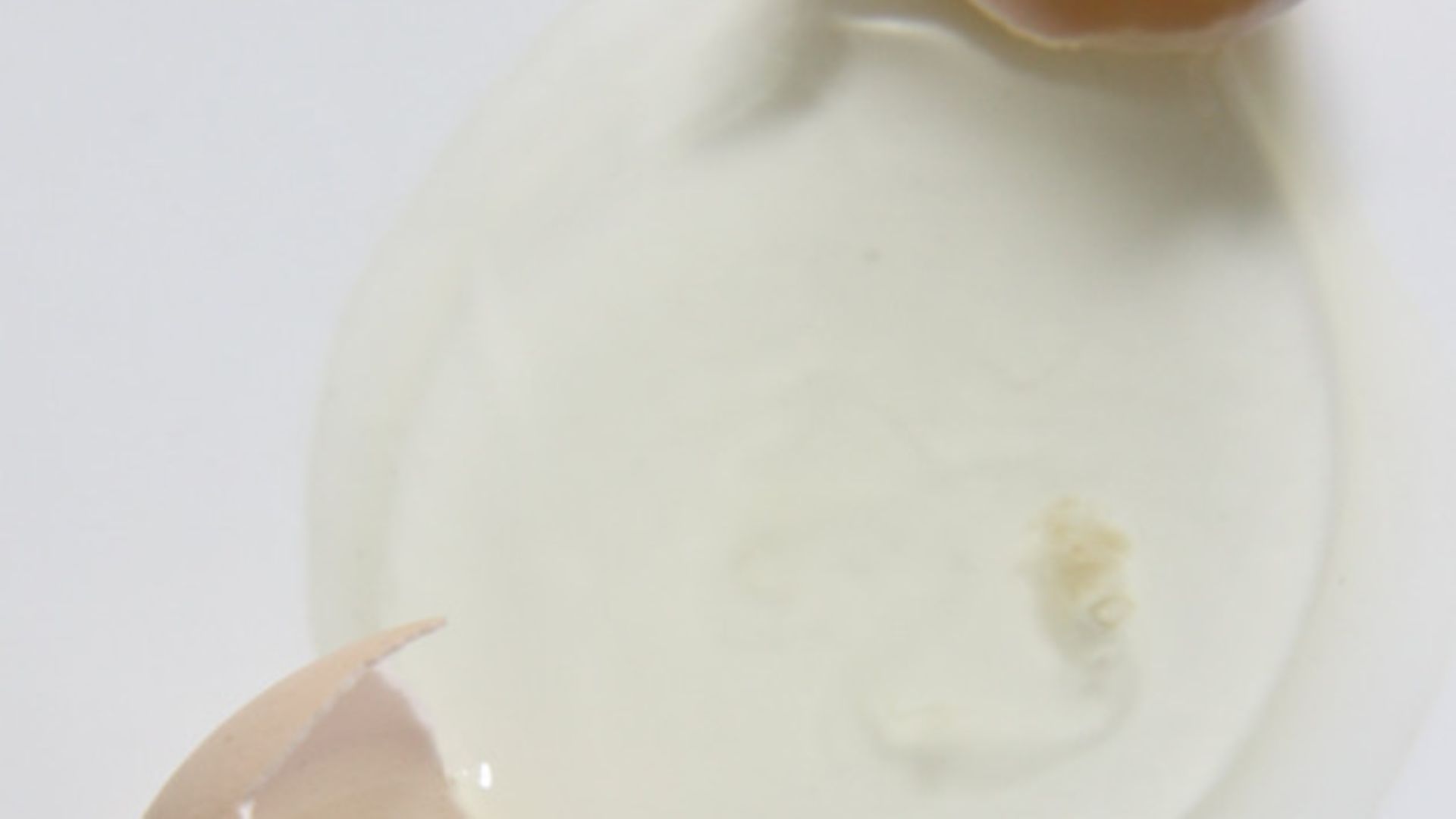We all know that chickens are strange creatures, and that sometimes they produce very strange eggs. Julie Moore explains why this happens

If you haven’t already had an odd in your nest box, it’s bound to happen at some point. Weird-looking eggs are common amongst back garden flocks and, in most cases, there is no need to worry.

To understand this phenomenon, we need to understand how a hen’s reproductive system should work and how problems can occur.

When a female chick (pullet) hatches, her ovary is fully formed and contains up to 4,000 tiny developing yolks or ova which could theoretically be laid. However, most of these ova will never develop. The maximum number of eggs a hen can lay in her life is determined when she hatches as no new ova are added after hatching.
Each ovum (singular of ova) is enclosed in a thin-walled sac attached to the ovary. The mature yolk is released when the sac ruptures from the ovary into the second part of the hen’s reproductive system, the oviduct.
The oviduct is a long, convoluted tube typically 63 – 69cm (25 – 27inches) when fully developed. It consists of five major sections, each of which plays an important role in the formation of an egg: the infundibulum, the magnum, the isthmus, the shell gland or uterus and the vagina.
The infundibulum is a 7.5 – 10cm (3 – 4inches) long muscle which engulfs the ovum from the ovary. If fertilisation is going to occur, it happens here in the infundibulum. Following mating, sperm enters the hen’s oviduct and is stored within sperm storage glands — only sperm that can swim will be stored. Sperm can remain alive and viable in these glands for up to two weeks. As sperm do not break through the egg shell, they instead travel up the oviduct to the infundibulum to join with the egg yolk. As the ovum remains here for 15 – 18 minutes, there’s only a short window of opportunity for fertilisation to take place.
The next section is the magnum and at 33cm (13 inches) long is the largest part of the oviduct. The ovum remains here for three hours during which time the white or albumen is added.
The third section is the isthmus which is 10cm (4 inches) long. The developing egg remains here for around 75 minutes whilst the inner and outer shell membranes are added.
The fourth section of the oviduct is the shell gland or uterus and is 10 – 12.5cm (4 – 5inches) long. As the name implies, it’s here that the shell, made up mainly of calcium carbonate, is placed on the egg. This process takes 20 hours or more to complete. Pigment deposition, if any, is also carried out in the shell gland.
The final part of the oviduct is the vagina which is 10 – 12.5cm (4 – 5 inches) long. The vagina is made of muscle which helps to push the egg out of the hen’s body. As the last step in the egg laying process, a thin, nearly invisible layer called the bloom is applied to the egg shell in the vagina. This coating seals the thousands of tiny shell pores, preventing air and bacteria from getting inside the egg and reducing moisture loss from within the egg.
It takes around 25 – 26 hours to form a new egg. The release of the next ovum typically occurs between 30 and 75 minutes after the previous egg was laid. As hens do not typically ovulate after 3pm, eventually she’ll lay so late in the day that she’ll delay ovulation until the following day. In this case, there will be a day when she does not lay an egg.
You can tell from looking at the yolk of a cracked egg whether it is fertile or infertile. Every egg contains a concentration of cells containing the hen’s genetic material on the yolk. These cells are termed the blastodisc and can be identified as a light coloured dot with irregular borders on infertile eggs.
To produce a fertile egg, a hen must mate with a rooster so that the egg contains both the male and female genetic material required to create an embryo. When an egg is fertilised by a rooster, the blastodisc becomes the blastoderm and is the first stage of embryo development. The blastoderm can be identified by its multi-ringed bull’s eye appearance, having regularly shaped concentric circles. It’s very prominent on the yolk and indicates that, had the egg not been cracked into a bowl but incubated under the correct conditions for 21 days, the blastoderm may have developed into a chick.
Given that the formation of an egg is such a complex process, it’s hardly surprising that sometimes things go wrong and you’ll find eggs with either shell defects or internal irregularities.
Occasionally, an egg will be laid without a shell — it doesn’t look appetising and feels like a water balloon. The shell membranes were placed on the yolk and egg white but somehow the shell wasn’t deposited. As the shell forms just before an egg is laid, stress caused by fright or excitement can cause a hen to lay prematurely before the shell is complete. Sometimes, pullets coming into lay, particularly if they have matured early may lay shell-less eggs simply because their reproductive system isn’t properly developed. A diet deficient in calcium or vitamin D can also cause soft shells. The occasional shell-less egg is nothing to worry about, but if they persist, it may be a sign of a disease such as infectious bronchitis or Newcastle disease which is something to worry about and an avian veterinarian should be consulted.
Thin shells may cover a pullet’s first few eggs because her body isn’t properly geared up to egg production. At the other end of the age spectrum, you’ll find that older hens lay thin-shelled eggs. For an older hen, the same amount of shell material that once covered the smaller eggs that she laid in her youth must cover the larger eggs that she now lays. You’ll find that shells are generally thicker and stronger in the winter and thinner in warm weather when hens pant. As hens have no sweat glands, they pant to cool themselves. Panting evaporates body water which reduces carbon dioxide in the body, upsetting the PH balance and decreases the hen’s ability to store calcium, resulting in thin-shelled eggs. Thin shells may also be hereditary, caused by an imbalanced diet or disease, the most likely being infectious bronchitis.
Other things can go wrong whilst an egg shell is being developed. Sometimes, the shell becomes damaged whilst still in the shell gland from stress or pressure and is repaired prior to being laid. This results in the egg being marked by a groove and is known as a body checked egg. These checks are usually found at the ends of the eggs, especially the pointed end. Checks in the middle completely encircle the egg.
Rough shells refer to eggs with rough-textured areas, often unevenly distributed over the shell. Such eggs are often the result of double ovulation which produces one shell-less egg and another one with extra shell deposits. This could be caused by sudden changes in lighting conditions or a defective shell gland.
Pimples are small lumps of calcified material on the egg shell. Some can be broken off easily without damage to the shell whilst others may leave a small hole in the shell. Pimples result from an excess calcium intake.
If an egg is kept too long in the shell gland, the resulting egg is flat-sided with wrinkles. They are most commonly produced by young pullets and may be the result of double ovulation.
Unusually large eggs are typically double yolkers. This phenomenon typically occurs in young pullets when the yolk release is mistimed and two yolks travel down the oviduct in quick succession. Some hens have a genetic trait in them to lay double yolkers. The largest egg I’ve ever had was a whopping 115grams which is rather small in comparison to the world record breaker which weighed in at 201grams.
At the other end of the spectrum are tiny eggs known as wind eggs which often contain no yolk. They are typically laid by young pullets because the reproductive system isn’t quite in synch. Older hens can also lay wind eggs. In this scenario, a piece of tissue from the ovary or oviduct breaks free and tricks the hen’s reproductive system into treating the tissue like a yolk, creating an egg out of it.
If you use your own eggs for hatching, you should select eggs of normal shape and size.
Another oddity chicken keepers commonly see are blood and meat spots. It’s rare to find these conditions in commercially produced eggs as eggs displaying these characteristics are removed during candling before they reach the shelves of the store.
Blood spots are normally found on the yolk and result from a small break in one of the tiny blood vessels around the yolk when it is being released from the ovary or as it travels through the oviduct. Blood spots can occur in: older hens, those hens that are genetically inclined to lay such eggs, hens deficient in vitamin A or any random egg.
Meat spots on the other hand are found in the egg white (albumen) and are brown in colour. They are formed when small pieces of the wall of the oviduct are shaved off as the egg white is being added during the egg formation process. Although visually unappetising, meat spots are perfectly safe to eat, but they can be easily removed with the tip of a knife, if desired.
There is an array of different coloured egg shells and colourings vary within breeds. You’ll find that although an individual hen will lay the same colour egg throughout her laying life, she’ll start laying darker eggs at the beginning of the season after the winter break. The amount of pigment will lessen throughout a hen’s laying cycle so she will lay progressively lighter eggs. Older hens will also create less pigment even though their genetic material remains unchanged — they can pass the genetics for the pigment they had in their youth to their daughters, assuming that the rooster’s genetics support this too. Other factors can impact egg colour including: exposure to too much heat can cause stress resulting in a bleached effect on the egg shell; the presence of mites or disease can also cause paler than normal shells; uneven shell colouring can be caused if the egg spends extra time in the shell gland allowing more time for pigment to be applied.
All egg shells start out as white eggs. White eggs have no pigment at all. Coloured eggs have their pigment added to the shell at the end of the shell formation process in the shell gland.
Brown eggs are the result of the pigment protoporphyrin, (a by-product of haemoglobin in the hen’s blood) being deposited on the egg shell during the last part of the formation of the egg. The brown colouring is not part of the shell, but more like paint on the surface which can be easily rubbed off.
Different breeds have differing amounts of pigments which is why Buff Orpingtons lay pale brown eggs whilst Marans lay dark, chocolate brown eggs.
Blue eggs are produced by a pigment called oocyarin which is a product of bile formation. The colouring is applied early in the shell formation and penetrates the entire shell, both inside and out. The colouring cannot be rubbed off. Araucanas and Cream Legbars are examples of blue egg layers.
Green eggs are a combination of blue and brown pigments being added during the egg formation process. Green eggs are blue on the inside since the blue pigment is applied in the early stages of egg development. The brown pigment is then deposited on top of the blue colour later in the process, resulting in a greenish egg shell.
Understanding how a hen’s reproductive system functions can be fundamental when you pick up that weird looking egg from the nest box. Whilst immature shell glands in new layers may be responsible for a number of egg oddities, these are generally no cause for concern unless the irregularities persist. Odd shaped eggs in mature hens may result from stress or a defective shell gland. Diseases such as infectious bronchitis and egg drop syndrome can cause misshapen eggs and are something to worry about. If a hen is consistently laying irregular eggs, you should consult an avian veterinarian.
Image(s) provided by:
Archant







